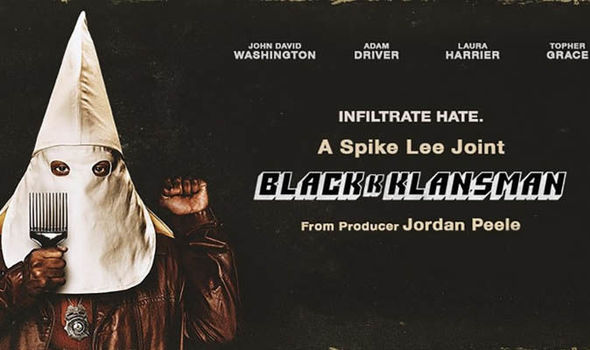On the first anniversary of the Neo-Nazi march in Charlottesville, Spike Lee released his latest joint, BLACKkKLANSMAN. The film is based on the impossibly true story of a Black police officer in Colorado Springs who, in 1979, managed to infiltrate the KKK and even met David Duke. Lee uses the film – which he links explicitly to Charlottesville – to comment on racism in America, and in particular, to argue for the important difference between White Power and Black Power movements.
BLACKkKLANSMAN features multiple scenes – usually juxtaposed – of Black Power and White Power meetings. The film’s inciting incident is Ron’s assignment to infiltrate a Black Student Union event where Kwame Ture (aka Stokely Carmichael) spoke. Ture was a former Black Panther who at the time of the film was organizing and leading the All-African People’s Revolutionary Party (which isn’t discussed in the film). Ture’s rhetoric is reminiscent of Malcolm X – unsurprising, since the two worked together. Throughout his speech, which criticizes the Vietnam War and indiscriminate killing of Black men by White police officers, Ture and the crowd frequently raise a fist and shout, “Black Power!” or, more often, “All Power to All the People!”
At first blush, it might seem the only real difference between the Black Power movement and the KKK chapter Ron and Flip infiltrate is that the latter uses any number of racial slurs. But as the film progresses, Lee carefully illustrates the wide gulf between the two movements, culminating in a powerful sequence where the two groups’ meetings are cut together to show that no, in fact, White Power and Black Power are not two equally racist versions of each other.
This objection to racial rhetoric – that pro-Black speech and activity is equally racist to pro-White speech and activity is a common response from many White persons to cries for racial justice. When activists insisted “Black Lives matter,” White persons objected that “All lives matter!” Point out the dearth of roles for Black actors that don’t want to play a pimp, prostitute or drug dealer, and you’ll probably hear how racist Black Entertainment Television is. (“Imagine the outcry if there were a White Entertainment Television!” they exclaim.) Or point out how poorly Evangelical churches create truly diverse spaces where Whiteness isn’t centered in the worship experience and brace yourself for at least one person to point out that persons of color often choose not to be in white churches. Nowhere was this perhaps more evident than in President Trump’s remarks a year ago following the Neo-Nazi march in Charlottsville, WV, when he insisted there was “blame on both sides,” going so far as to imagine the counter-protesters as “alt-left.”
Again and again the refrains reveal the underlying assumption: Yes, the Whites-only rhetoric of the Alt-Right, the KKK and other White Supremacist groups is racist. But so is the Black-centric rhetoric of the ‘other side’. This insistence – that Pro-White and Pro-Black advocates are morally equivalent and equally racist – is only possible if one ignores the content of the rhetoric, something Lee’s film makes it impossible to do.
The racism of the KKK in the film (and of today’s Alt-Right White Supremacists) is obvious. They believe persons of color are inferior culturally and biologically to Europeans. Though they will insist, as does David Duke in the film, that they don’t hate Black people, it’s clear they believe Blackness is inherently, essentially inferior to Whiteness. Love and hate have nothing to do with it.
But being overtly anti-Black isn’t the only way to be racist. In his excellent book Stamped from the Beginning, Ibram X. Kendi establishes three ways to explain racial inequality evident throughout American history. He calls the first group ‘segregationists’ – they’re the ones who think the races should always be kept separate because Whiteness is always, inherently superior to other races. For Segregationists, racial inequality exists because the races are fundamentally unequal. The third group Kendi calls ‘Antiracists’. This is the group that knows racial inequality is the product of racial discrimination. It’s the second group that’s most subtle and insidious. Kendi calls them ‘Assimilationists’. Assimilationists believe that racial inequality is a product of both Blackness and racial discrimination.
Kendi writes,
In embracing biological racial equality, assimilationists point to environment—hot climates, discrimination, culture, and poverty—as the creators of inferior Black behaviors. For solutions, they maintain that the ugly Black stamp can be erased—that inferior Black behaviors can be developed, given the proper environment. As such, assimilationists constantly encourage Black adoption of White cultural traits and/or physical ideals.
Assimilationism is also White Supremacy. It doesn’t wear a cloak or hood and it doesn’t burn crosses. But Assimilationism believes that White culture is the standard by which ‘culture’ is judged. Consider, for instance, why suits are considered professional dress. The suit and tie is a Western cultural standard of dress. To assume that any American who wants to look professional should dress in a suit and tie is a White supremacist assumption, because it assumes that White culture is the standard for professionalism. Similarly, Dave Chapelle once observed on Inside the Actor’s Studio that “every Black American is bilingual” because “there’s a certain way we have to speak to have access.” By that, he meant that Black Americans have to be able to speak the way White people (who hold positions of power) expect – he tellingly refers to this as ‘job interview’ vernacular. Again, the assumption is that White speech patterns are considered ‘right’ or ‘correct’, and that Black speech patterns are deviations. But both are a far cry from the so-called King’s English of Shakespeare. Why is one considered ‘right’ and the other ‘wrong’? It’s all about who has power.
Beauty is another issue steeped in White Supremacy, one the Black Panthers and other Black activists emphasized heavily in the 60s and 70s. Black activists recognized that a culture that assumes Whiteness is the default “normal” had taught them to hate their Blackness. Black bodies, Black skin, Black music, Black perspective – these are all subtly and not-so-subtly regarded as abnormal, dangerous, evil or inferior in a culture that privileges Whiteness. So these activists pushed back. They insisted “Black is beautiful.” It’s no accident that during Ture’s speech in the opening Black Power rally, he repeatedly insists “Black is beautiful” while the camera shows a score of Black faces, nor that the following scene is an extended sequence of music and dancing in a Black nightclub. Lee pauses to celebrate the beauty of Blackness even as the KKK (explicitly) and larger American culture (implicitly) insists this very Blackness is inferior. White Supremacy is not just marching with tiki torches and burning crosses. It’s also holding Whiteness up as the norm in any area: beauty, dress, speech, music, etc. Assimilationism is White Supremacy no less than Segregationism.
Also no accident are the prominent placement of Nixon campaign posters in White Supremacist spaces, even though the film is set in 1979, five years after Watergate and Nixon’s resignation. Nixon’s two (successful) presidential campaigns in 1968 and 1972 relied heavily on the “Southern Strategy” developed by his advisors to gain Democrat votes. The Southern Strategy essentially rebranded racism and white supremacy using what have come to be known as “dog whistles“. Thanks to the Civil Rights movement and the activism of Dr. King, Malcolm X, Ture and others, overt, segregationist racism had become socially unpopular, even in the Deep South. By employing coded language – like “Law & Order,” “Welfare Queen” or “Tough on Crime” – politicians connect social issues to communities and persons of color. Nixon’s dog whistle campaign tactics invited thousands of racist White Americans to vote for him, and his Southern Strategy was instrumental in the massive switch in the Republican party from being the party of Lincoln to one today whose politicians often oppose Civil Rights. The film makes much of David Duke’s movement into assimilationist rhetoric to achieve his goal of getting a White Supremacist in the White House.
All of these details inform the canvas on which Lee constructs his antiracist argument that plays out in two of the film’s final sequences. The first is those two juxtaposed rallies – one in which Flip as White Ron is inducted into the KKK by none other than David Duke himself, and the other in which a (fictitious) activist Jerome Turner recounts the (very real) lynching of Jesse Washington. Both scenes center on the retelling of history. At the Black meeting, the centerpiece is Turner’s recounting of the lynching, while he is flanked by students holding giant pictures of the events. At the White meeting, the centerpiece is a viewing of Birth of a Nation, the 1916 blockbuster film that reinvigorated the KKK and sparked the wave of lynchings of which Jesse Washington’s was a part. Birth of a Nation is textbook segregationist racism. Based on a book called The Clansman which was written as a response to Uncle Tom’s Cabin, the film depicts the Klan as heroes of White culture, defending White women from the evil advances of Black men (who were White actors in Blackface). The film’s climatic scene features a White woman leaping to her death rather than be raped by a Black man (again, actually a White actor in Blackface).
Meanwhile, Turner recounts Washington’s lynching. Washington was convicted (by an all-White jury) of raping a White woman. More than 10,000 White Texans gathered to watch his lynching, including children who came from school during their lunch hour. The mob tortured Washington, mutilating his body, burning him alive and dismembering his body. His body parts were sold off as souvenirs (a common practice in lynchings), and pictures of the lynching were sold in Waco as postcards.
In juxtaposing these two events, Lee reveals the foolishness of equating White and Black power movements. White Power is all about White Supremacy – both explicitly in segregationist rhetoric and implicitly in assimilationist politics. The White Power movement is all about reinforcing racial discrimination through cultural, political and economic systems that privilege Whiteness.
Black Power, on the other hand, is largely anti-racist (as with any movement, there is a spectrum with outliers). Ture’s insistence in the film, “All Power to All the People” is telling: Ture and the Black Student Union aren’t interested in an inverted society in which Blackness is privileged at the expense of Whiteness. Their goal is a world in which Blackness and Whiteness are held as equal. Equally beautiful. Equally powerful. Equally represented in the halls of power.
This is why the film ends on a shocking, terrifying note. The final image of the story is a burning cross, witnessed by Ron and Patrice. Despite Ron’s victory, the Klan is still very active. White Supremacy hasn’t gone anywhere. Lee then cuts to footage from Charlottesville and President Trump insisting there are “very fine people on both sides.” He ends with an image of the American flag upside down – a signal the country is in danger. As the flag’s colors fade to black and white, his plea is clear: We can’t fall for the lie of assimilationist racism. White Power and Black Power aren’t morally equivalent. To reject one does not entail a rejection of the other. One is about racism, segregationist and assimilationist. The other is about liberation, the equality and dignity of all persons.

